My Mother’s Peasant Bread: The Best Easiest Bread You Will Ever Make
This post may contain affiliate links. Please read my disclosure policy.
This is the no-knead bread recipe my mother has been baking for 45 years. Start to finish, it can be ready in three hours. It bakes in well-buttered Pyrex bowls — no need to preheat a baking vessel for this recipe — and it emerges golden and crisp with a soft, tender crumb. 🍞🍞🍞🍞🍞
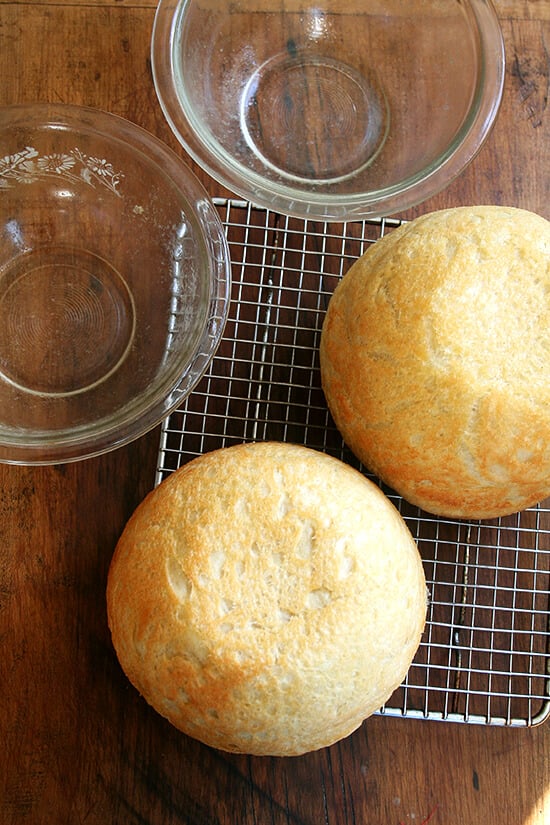
When I tell you that, if forced, I had to pick one and only one recipe to share with you that this — my mother’s peasant bread — would be it, I am serious. I would almost in fact be OK ending the blog after this very post, retiring altogether from the wonderful world of food blogging, resting assured that you all had this knowledge at hand. This bread might just change your life.
The reason I say this is simple. I whole-heartedly believe that if you know how to make bread you can throw one hell of a dinner party. And the reason for this is because people go insane over homemade bread. Not once have I served this bread to company without being asked, “Did you really make this?” And questioned: “You mean with a bread machine?” But always praised: “Is there anything more special than homemade bread?”
And upon tasting homemade bread, people act as if you’re some sort of culinary magician. I would even go so far as to say that with homemade bread on the table along with a few nice cheeses and a really good salad, the main course almost becomes superfluous. If you nail it, fantastic. If you don’t, you have more than enough treats to keep people happy all night long.
The Magic of the Peasant Bread
So what, you probably are wondering, makes this bread so special when there are so many wonderful bread recipes out there? Again, the answer is simple. For one, it’s a no-knead bread. I know, I know. There are two wildly popular no-knead bread recipes out there.
But unlike the others, this is a no-knead bread that can be started at 4:00pm and turned out onto the dinner table at 7:00pm. It bakes in well-buttered Pyrex bowls — there is no pre-heating of the baking vessels in this recipe — and it emerges golden and crisp without any steam pans or water spritzes. This is not artisan bread, nor is it trying to be. It is peasant bread, spongy and moist with a most-delectable buttery crust.
Genuinely, I would be proud to serve this bread at a dinner party attended by Jim Lahey, Mark Bittman, Peter Reinhart, Chad Robertson, Jeff Hertzberg and Zoe Francois. It is a bread I hope you will all give a go, too, and then proudly serve at your next dinner party to guests who might ask where you’ve stashed away your bread machine. And when this happens, I hope you will all just smile and say, “Don’t be silly. This is just a simple peasant bread. Easy as pie. I’ll show you how to make it some day.”
Peasant Bread Variations
Once you master the peasant bread, you can make any bread your heart desires — this simple no-knead bread recipe is the foundation of many of the other bread recipes on this site, namely this hugely popular overnight refrigerator focaccia and this simple homemade pizza dough. It’s even the inspiration behind this sourdough focaccia and this sourdough sandwich bread and this simple pita bread recipe.
The below post is organized as follows:
- How to Make Peasant Bread, Step by Step
- The Best Way to Store Bread
- Peasant Bread Dinner Rolls
- Peasant Bread Sandwich Bread
- How to Add Seeds and Nuts to Bread Dough
- How to Make Gluten-Free Peasant Bread
- How to Coat the Loaves in Seeds
- How to use Whole Wheat Flour
- How to Bake the Peasant Bread in a Dutch Oven
Many more variations on the peasant bread can be found in my cookbook, Bread Toast Crumbs:
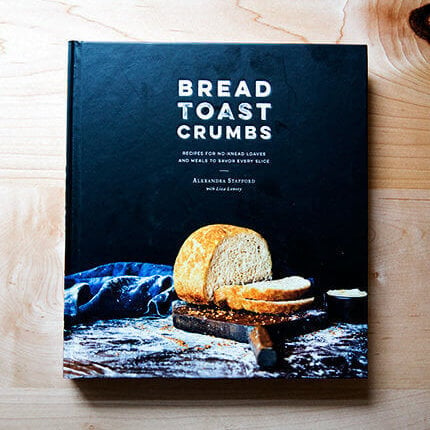
Bread Toast Crumbs
Love the peasant bread? There’s now a book filled with 40 simple bread recipes plus 70 recipes to use up every crumb of every loaf you bake.
How to Make Peasant Bread, Step by Step
First: You need yeast.
This is the yeast I buy exclusively: SAF Instant Yeast. Instant yeast can be whisked into the flour directly without any blooming or proofing. If you want to stick to active-dry yeast, there are instructions in the recipe notes on how to do so. Red Star yeast is great.

Whisk together flour, salt, sugar, and instant yeast. Add lukewarm water.
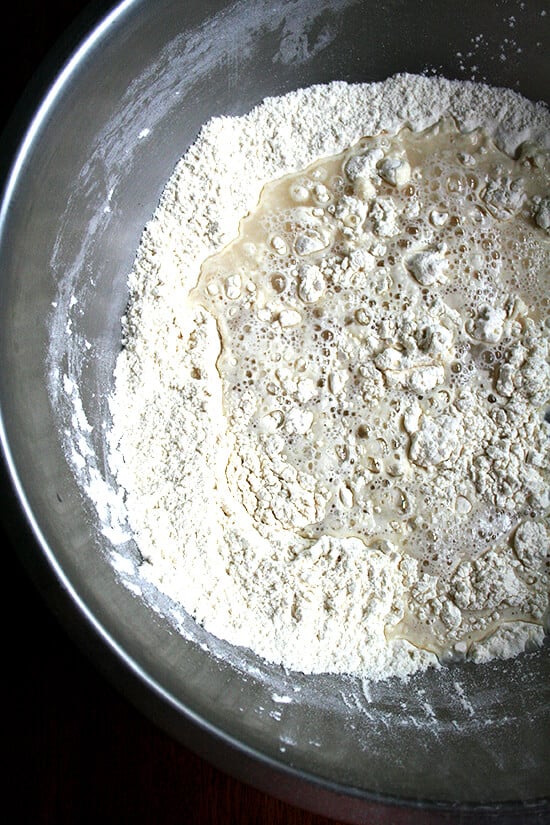
Mix until you have a sticky dough ball. Let it rise for 1.5 to 2 hours…
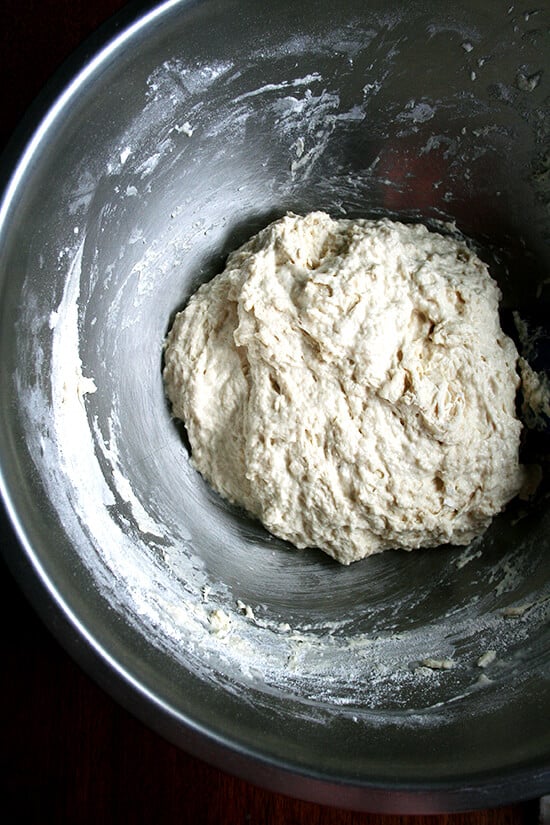
… or until it looks like this:

Punch down the dough using two forks.
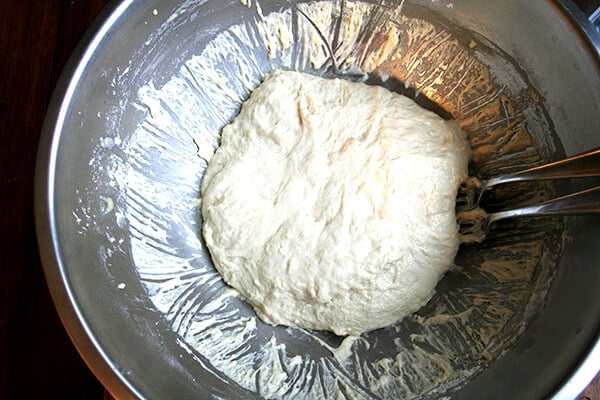
Then split the dough down the middle again using the two forks.

Because this is a very wet dough, it must be baked in an oven-proof bowl. I am partial to the Pyrex 1L 322 size, but any similarly sized oven-proof bowl will work.

Butter the bowls well; then transfer half of the dough to each prepared bow.

Let the dough rise again until it crowns the rim of the bowl, about 30 minutes.
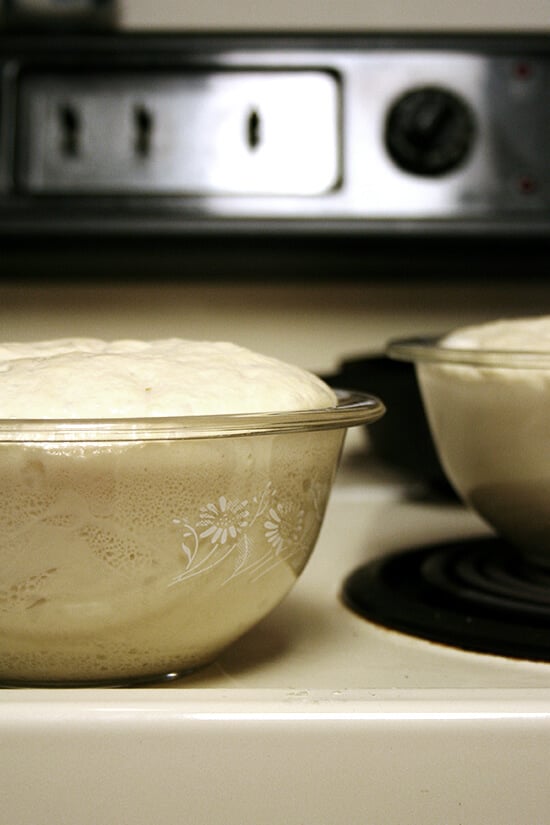
Transfer the bowls to the oven to bake:


This bread is irresistible when it’s freshly baked, but it also makes wonderful toast on subsequent mornings as well as the best grilled cheese. It’s also my favorite bread to use for these egg salad sandwiches and for this no-tuna “tuna” salad.

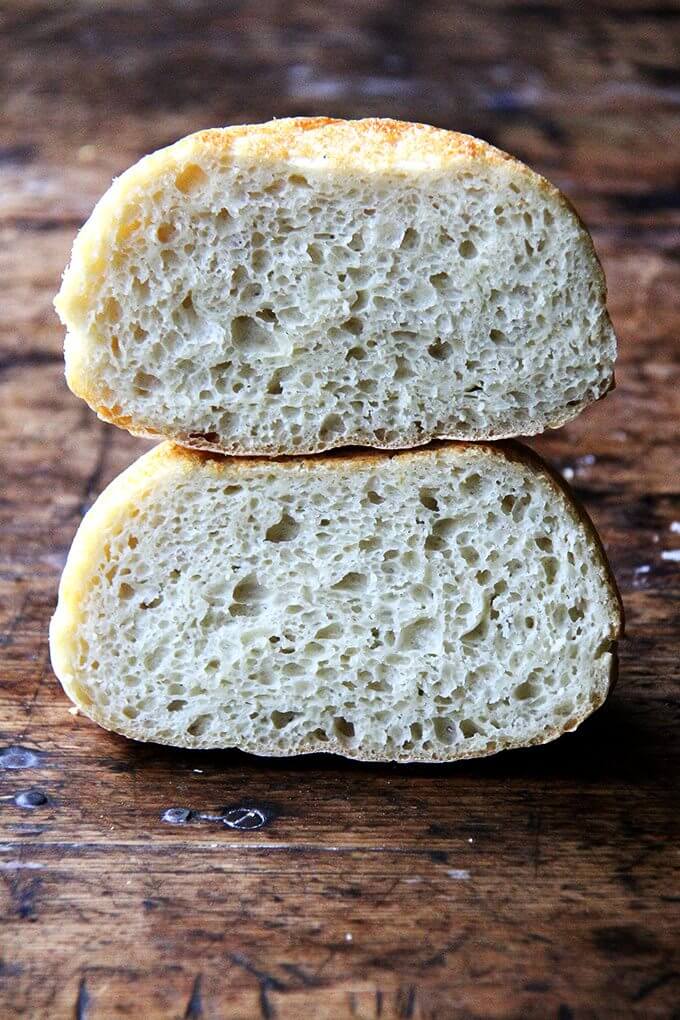
The Best Way to Store Bread
If you want to store the bread at room temperature for 3 to 4 days, I think the best method is in a ziplock bag. I’ve tried other eco-friendly options, but nothing seems to keep bread freshest — the crumb the softest — better than a ziplock bag. You can re-use the bags again and again.
If you intend to keep the bread for longer, I would freeze it. I often slice bread as soon as it cools completely, transfer the slices to a ziplock bag, then freeze. This way, I know the bread was frozen at its freshest.
A ziplock bag will not prevent the crust of bread from turning soft, which is why I suggest always reheating day-old bread. I use a toaster at breakfast for slices of bread, and I reheat half or quarter loaves in the oven at 350ºF for 15 to 20 minutes when serving for dinner.
Bread revives so beautifully in the oven or toaster.

No-Knead Dinner Rolls
To use the peasant bread dough to make rolls, simply divide the dough into smaller portions and place in a buttered muffin tin as in these No-Knead Thyme Dinner Rolls (pictured above). This recipe for no-knead buttermilk pull-apart rolls is also based on the peasant bread as are these brioche pull-apart rolls.
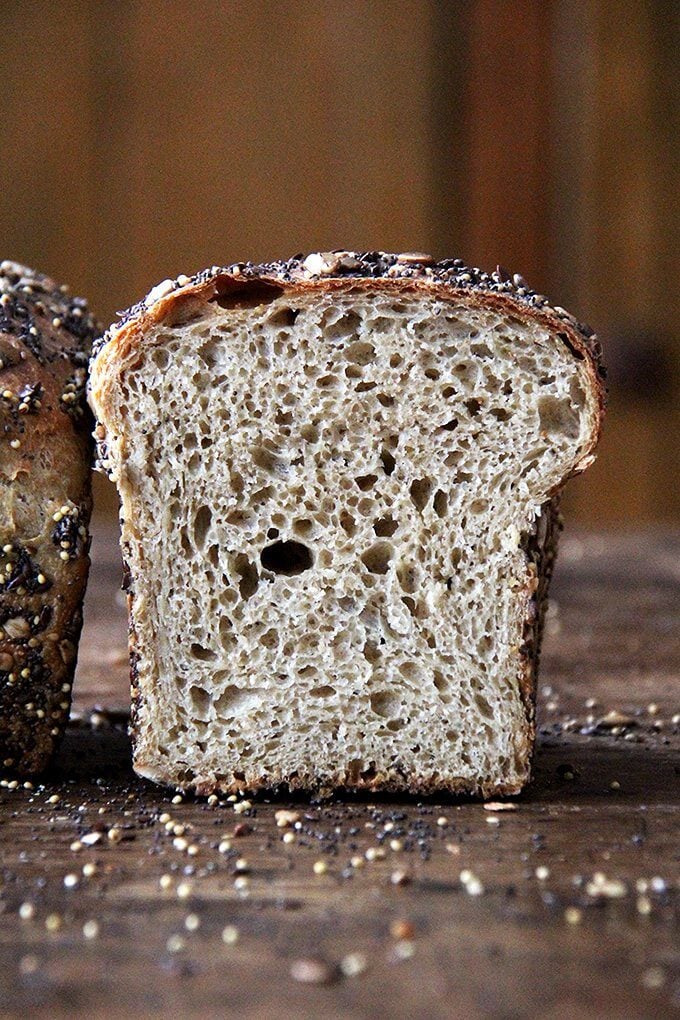
No-Knead Sandwich Bread
To make sandwich bread, multiply the recipe below by 1.5 and bake the bread in two buttered 8.5×4.5-inch loaf pans.
Made with half all-purpose flour and half King Arthur Sprouted Wheat Flour, these seed-coated sandwich loaves (pictured above) have a soft and light crumb. I really like KAF’s sprouted wheat flour, which is made from white whole wheat berries that, when sprouted, yield a creamy, sweet, milder-tasting flour. You can use 100% all-purpose or bread flour for an even lighter loaf or your favorite whole wheat flour in place of the sprouted wheat flour.
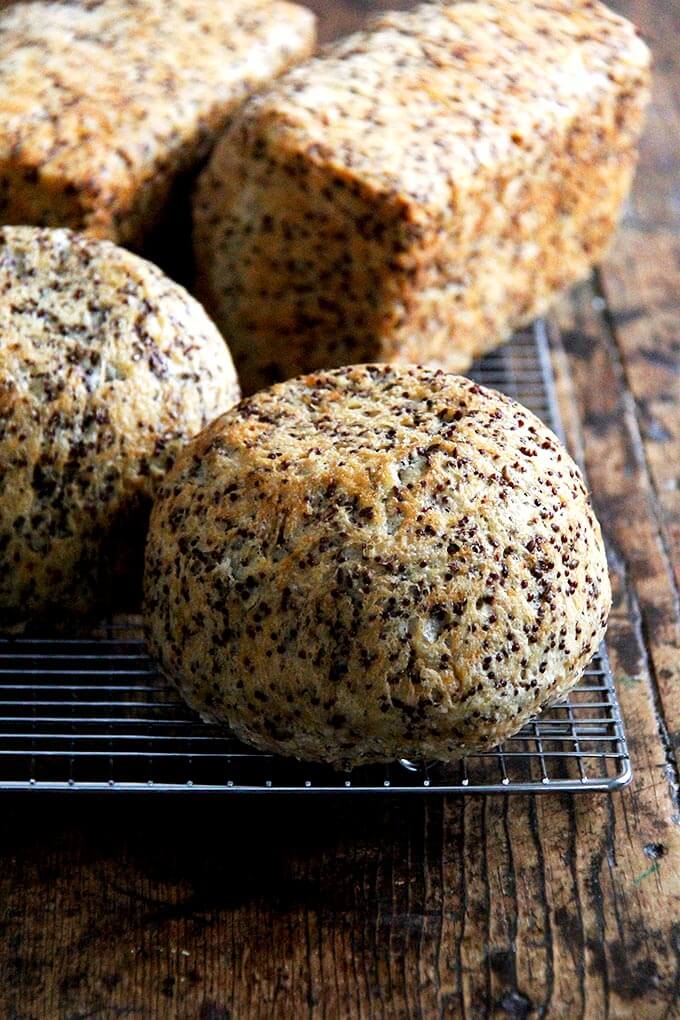
How to Add Nuts and Seeds to Bread Dough
To add seeds and nuts (or dried fruit and cheese), simply stir them into the dry ingredients. This recipe for Quinoa-and-Flax Toasting Bread will offer guidance on how much to add.

How to Make a Gluten-Free Peasant Bread
Making gluten-free peasant bread (pictured above) unfortunately isn’t as simple as swapping in gluten-free flour for the wheat flour. But the process and recipe is still super simple — in fact, because there’s only one rise, many people find the gluten-free peasant bread to be even simpler than the original. Find the recipe here: Gluten-Free Peasant Bread

How to Coat the Loaves in Seeds
To coat the peasant bread in seeds, as pictured above, simply coat the bowls with everything bagel seasoning or with dukkah or sesame seeds or whatever seed mix you wish. The seed-coated loaves look so beautiful, and it’s amazing how much the flavor of the coating permeates the loaves. Find the recipe here: Everything Bagel Seasoning Peasant Bread

How to Use Whole Wheat Flour
To use whole wheat flour in the peasant bread, simply replace as much as 50% of the all-purpose flour with your favorite whole wheat flour: I like KAF’s sprouted wheat flour, and I’ve been loving the Cairnsprings Mill Trailblazer stone-milled flour. With the Trailblazer, I can use up to 75% of it in the peasant bread, and it yields a beautiful, chewy texture as well as a lovely flavor and aroma.
When using whole wheat flour, you may have to use more or less water — there is no rule as to how much more or less, and it will take some trial and error to get right because all flours absorb water differently. When I use KAF sprouted wheat flour, for example, I don’t change the water amount at all. When I use the Trailblazer flour, on the other hand, I reduce the water by at least 50 grams.
If you’d like to learn more about whole wheat flour and stone-milled flours, read this: Easy Sourdough Bread (Whole Wheat-ish)
How to Bake the Peasant Bread in a Dutch Oven
If you’re looking for more of a crackling crusted boule (characteristic of a loaf of sourdough bread) as opposed to the buttery crispness of the peasant bread, you can bake the peasant bread dough in a preheated Dutch oven.
There are detailed instructions below the recipe in the notes section, but one thing to keep in mind before you begin is dough hydration. The peasant bread is a very high hydration dough, meaning there is a lot of water relative to flour. Because baking the peasant bread in a Dutch oven will require some handling of the dough — to shape it into a round and to create some tension — you may want to reduce the water from the start. Consider holding back 20-30 grams of water to make the process more manageable for you.
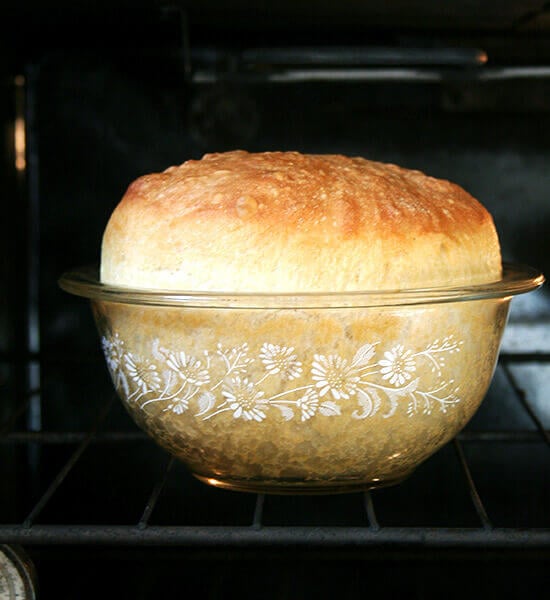
My Mother’s Peasant Bread: The Best Easiest Bread You Will Ever Make
- Total Time: 2 hours 27 minutes
- Yield: 2 loaves
Description
Notes:
The bread:
This is a sticky, no-knead dough, so, some sort of baking vessel, such as pyrex bowls (you need two 1-qt bowls) or ramekins for mini loaves is required to bake this bread. See notes below the recipe for sources. You can use a bowl that is about 2 qt or 2 L in size to bake off the whole batch of dough (versus splitting the dough in half) but do not use this size for baking half of the dough — it is too big.
Peasant Bread Fans! There is now a book: Bread Toast Crumbs, a loaf-to-crumb bread baking book, filled with tips and tricks and answers to the many questions that have been asked over the years. In the book you will find 40 variations of the master peasant bread recipe + 70 recipes for using up the many loaves you will bake. Learn more about the book here or buy it here.
Ingredients
- 4 cups (512 g) unbleached all-purpose or bread flour
- 2 teaspoons (10 g) kosher salt
- 2 cups (454 g) lukewarm water (made by mixing 1.5 cups cold water with 0.5 cup boiling water)
- 2 teaspoons (8 g) sugar
- 2 teaspoons (8 g) instant yeast, I love SAF Instant Yeast, see notes below
- room temperature butter, about 2 tablespoons
Instructions
- Mixing the dough: In a large mixing bowl, whisk together the flour, salt, sugar, and instant yeast (I love SAF Instant Yeast). Add the water. Mix until the flour is absorbed. (If you are using active dry yeast, see notes below.)
- Let it rise. Cover bowl with a tea towel or plastic wrap and set aside in a warm spot to rise for at least an hour. (In the winter or if you are letting the bread rise in a cool place, it might take as long as two hours to rise.) This is how to create a slightly warm spot for your bread to rise in: Turn the oven on at any temperature (350ºF or so) for one minute, then turn it off. Note: Do not allow the oven to get up to 300ºF, for example, and then heat at that setting for 1 minute — this will be too hot. Just let the oven preheat for a total of 1 minute — it likely won’t get above 100ºF. The goal is to just create a slightly warm environment for the bread.
- Preheat the oven to 425ºF. Grease two 1-qt or 1.5-qt oven-safe bowls (see notes below) with about a tablespoon of butter each. Using two forks, punch down your dough, scraping it from the sides of the bowl, which it will be clinging to. As you scrape it down try to pull the dough toward the center (see video below for guidance). You want to loosen the dough entirely from the sides of the bowl, and you want to make sure you’ve punched it down. Then, take your two forks and divide the dough into two equal portions — eye the center of the mass of dough, and starting from the center and working out, pull the dough apart with the two forks. Then scoop up each half and place into your prepared bowls. This part can be a little messy — the dough is very wet and will slip all over the place. Using small forks or forks with short tines makes this easier — my small salad forks work best; my dinner forks make it harder. It’s best to scoop it up fast and plop it in the bowl in one fell swoop. Some people like to use flexible, plastic dough scrapers for this step.
- Let the dough rise again for about 20 to 30 minutes on the countertop near the oven (or near a warm spot) or until it has risen to just below or above (depending on what size bowl you are using) the top of the bowls. (Note: Do not do the warm-oven trick for the second rise, and do not cover your bowls for the second rise. Simply set your bowls on top of your oven, so that they are in a warm spot. Twenty minutes in this spot usually is enough for my loaves.)
- Bake it. Bake for 15 minutes. Reduce the heat to 375º and bake for 15 to 17 minutes longer. Remove from the oven and turn the loaves onto cooling racks. If you’ve greased the bowls well, the loaves should fall right out onto the cooling racks. If the loaves look a little pale and soft when you’ve turned them out onto your cooling racks, place the loaves into the oven (outside of their bowls) and let them bake for about 5 minutes longer. Remove from oven and let cool for 10 minutes before cutting.
Notes
- The bowls: The cheapest, most widely available 1-qt bowl is the Pyrex 322. Update: These bowls are becoming harder to find and more expensive. As a result, I’m suggesting this cheaper option: the Pyrex 3-piece set. You can split the dough in half as always (see recipe) and bake half in the 1-quart bowl and half in the 1.5 quart bowl. The loaves will not be the same shape, but they will be delicious nonetheless.
- Yeast: I buy SAF Instant Yeast in bulk from Amazon I store it in my fridge or freezer, and it lasts forever. If you are using the packets of yeast (the kind that come in the 3-fold packets), just go ahead and use a whole packet — It’s 2.25 teaspoons. I have made the bread with active dry, rapid rise, and instant yeast, and all varieties work. The beauty of instant yeast is that there is no need to “proof” it — you can add the yeast directly to the flour. I never use active-dry yeast anymore.
- If you have active-dry yeast on hand and want to use it, here’s how: In a small mixing bowl, dissolve the sugar into the water. Sprinkle the yeast over top. There is no need to stir it up. Let it stand for about 10 to 15 minutes or until the mixture is foamy and/or bubbling just a bit — this step will ensure that the yeast is active. Meanwhile, in a large bowl, whisk together the flour and salt. When the yeast-water-sugar mixture is foamy, stir it up, and add it to the flour bowl. Mix until the flour is absorbed.
- Troubleshooting: You can find step-by-step video instruction here.
- Several commenters have had trouble with the second rise, and this seems to be caused by the shape of the bowl they are letting the dough rise in the second time around. Two hours for the second rise is too long. If you don’t have a 1-qt bowl, bake 3/4 of the dough in a loaf pan and bake the rest off in muffin tins or a popover pan. The second rise should take no more than 30 minutes.
- Also, you can use as many as 3 cups of whole wheat flour, but the texture changes considerably. I suggest trying with all all-purpose or bread flour to start and once you get the hang of it, start trying various combinations of whole wheat flour and/or other flours.
- The single most important step you can take to make this bread truly foolproof is to invest in a digital scale. This one costs under $10. If you are not measuring by weight, do this: scoop flour into the measuring cup using a separate spoon or measuring cup; level off with a knife. The flour should be below the rim of the measuring cup.
- Here’s a printable version of this recipes that’s less wordy: Peasant Bread Recipe, Simplified
- How to Bake the Peasant Bread in a Dutch Oven: Preheat a Dutch Oven for 45 minutes at 450ºF. Dust a clean work surface with flour. After the first rise, turn the dough out onto the floured surface and shape it into a ball: I like to fold it envelope style from top to bottom, then side to side; then I flip it over and use the pinkie edges of my hands to pinch the dough underneath and create some tension. Transfer the dough to a sheet of parchment paper. Let rest for 20 minutes. If you feel your dough is spreading too much you can lift up the sheet of parchment paper, dough and all, and place it in a bowl of a similar size. After the 20 minutes, transfer the dough, parchment paper and all to the Dutch oven. Carefully cover it. Bake 30 minutes. Uncover. Bake 15 minutes more.
- To bake the peasant bread in a loaf pan: If you are using an 8.5×4.5-inch loaf pan or a 9×5-inch loaf pan, you can bake 3/4 of the dough in it; bake off the rest of the dough in ramekins or other small vessels … the mini loaves are so cute. You can also make 1.5x the recipe, and bake the bread in 2 loaf pans. If you have a large loaf pan, such as a 10×6-inch loaf pan, you can bake off the entire batch of dough in it. For loaf pans, bake at 375ºF for 45 minutes.
- How to Bake at Hight Altitude:
- First try the original recipe as written (preferably with a scale). You may not need to make any adjustments. One commenter, who lives at 9200 ft finds the original recipe to work just fine as is.
- If the original recipe doesn’t work, try adding a little bit more water because it rises fast and it is so dry: about a quarter cup for every 512 g of flour.
- Try decreasing the yeast to 1.5 teaspoons.
- If your dough is especially gooey, try decreasing the water by 1/4 cup. But, if you aren’t using a scale, my first suggestion would be to buy a scale and weigh the flour, and make the bread once as directed with the 2 cups water and 512 grams flour, etc.
- Punch the dough down twice before transferring it to the buttered Pyrex bowls. In other words, let it rise for 1-1.5 hours, punch it down, let it rise again for about an hour, punch it down, then transfer it to the buttered bowls.
- Variations:
- #1. Cornmeal. Substitute 1 cup of the flour with 1 cup of cornmeal. Proceed with the recipe as directed.
- #2. Faux focaccia. Instead of spreading butter in two Pyrex bowls in preparation for baking, butter one 9×9-inch glass baking dish and one Pyrex bowl or just butter one large 9×13-inch Pyrex baking dish. If using two vessels, divide the dough in half and place each half in prepared baking pan. If using only one large baking dish, place all of the dough in the dish. Drizzle dough with 1 tablespoon of olive oil (if using the small square pan) and 2 tablespoons of olive oil (if using the large one). Using your fingers, gently spread the dough out so that it fits the shape of the pan. Use your fingers to create dimples in the surface of the dough. Sprinkle surface with chopped rosemary and sea salt. Let rise for 20 to 30 minutes. Bake for 15 minutes at 425ºF and 17 minutes (or longer) at 375ºF. Remove from pan and let cool on cooling rack.
- #3. Thyme Dinner Rolls
- #4 Gluten-free
- #5. Everything Bagel Seasoning Bread. Simply coat the buttered bowls with Everything Bagel Seasoning. Watch a how-to on Instagram Stories here.
- #6: Whole Wheat Peasant Bread. Use as much as 50% whole wheat flour. I like King Arthur Flour’s white whole wheat flour (see this post) or sprouted wheat flour (see this post).
- Prep Time: 5 minutes
- Cook Time: 32 minutes
- Category: Bread
- Method: Baked
- Cuisine: American
This post may contain affiliate links. Please read my disclosure policy.

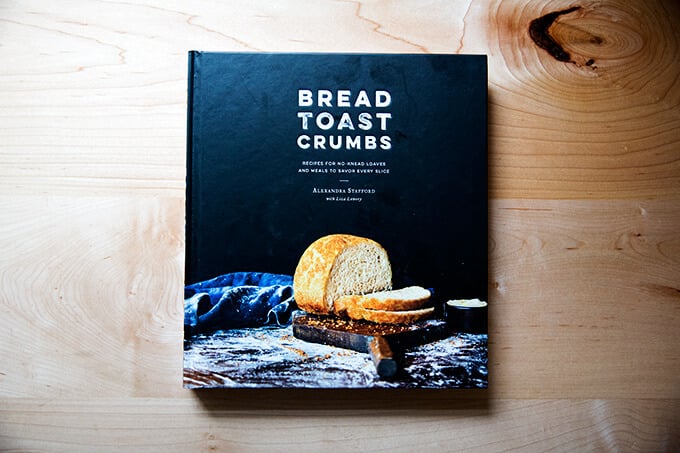













6,377 Comments on “My Mother’s Peasant Bread: The Best Easiest Bread You Will Ever Make”
I bought some super-sized Mason jars which I’ll be filling with homemade chicken noodle soup to deliver to friends on a cold winter day. Now I think I’ll add a loaf of homemade bread to the gift. How soul warming will that be? Thanks for the recipe!
Carey — that sounds amazing! What a wonderful treat that will be. Soul warming indeed.
if the person above doesnt have oven proof glass pyrex bowls you can use bread pans or a cast iorn or stainless steel pot to cook this bread in
I will turn my oven down from these tempts
I will try one loaf with cinnamon raisin & added sugar.
and the other loaf with rosemarry,garlic powder,dill and cheeses like parmesan and colbyjack and a pinch or caraway seed for a savory loaf to serve with dinner
the raisin bread …I will try to make it last for toast in the AM LOL
I have made one recipe like this with 1/4 cup pureed pumpkin and sugar,cinnamon and raisin too it was excellent
will make some in the Dutch style too with currants (lil dried currants that look like teeny tiny raisins…they are bought in boxes near raisins at the grocery store very good to make this in bread style or currant buns to serve with Gouda cheeses…especially the smoked version and a glass of nice wine too ummmm
Has anyone tried to make this recipe as rolls. My family loves homemade rolls and I was wondering if this recipe will work
Medina — you can make roll-like loaves in muffin tins or ramekins. Good luck with it!
I can’t wait to try this! I’m not much of a baker, so we’ll see if mine turns out as beautiful as your pictures.
Looks so easy! On the 2nd rise do you cover it with the tea towel and put back in the oven?
This is the first time I’ll be making bread, and this looks like the perfect recipe! However, I don’t have a loaf pan or a pyrex bowl. Could I use a regular 9″ cake pan for the first time? I’ll invest in a bread pan for subsequent bread making! Please let me know.
Sri — sorry I’m getting to you after the fact. So glad the bread turned out well for you! So, did you use the 9-inch cake pan?
This is the BEST bread recipe I’ve ever tried. My husband and neighbors LOVE it! I need to play with it a little more to get it to rise better but I’m going to try the oven trick on the next batch. Thanks so much for this! You’ve made me one happy momma.
Jennessa — so happy to hear this! The oven trick will help; the height it also dependent on the shape of the vessel. The smaller and narrower the bowl, the higher the loaf.
When you are letting the dough rise for the second time after you’ve divided into the bowls,are you supposed to cover them again with tea towels??
Cheers!
Elizabeth
Elizabeth — I do not for the second rise. I think because it’s relatively short (30 min or so) it doesn’t dry out on top. You certainly could, but just remove when you see the bread getting close to the towel — it’s a pain when the dough sticks to the towel. Happy baking!
Ok, ignore my question above. I made the bread and it is fantastic! Thanks!
Um…do we have to use oven safe bowls? I don’t think we have any, but we have bread pans coming out of our ears. 😀
Amanda – Bread pans will work just fine but the whole batch of dough might be too much for a standard loaf pan. Use maybe 3/4 of the dough in the loaf pan and bake mini loaves in ramekins or muffin tins. Hope that helps! I have never used the loaf pans but if you scroll through the comments some of the other readers have some suggestions that might be helpful.
I just took these out if the oven…I made one just like suggested, one more in a larger bowl so it came out more like focaccia, and 2 small ones in ramekins. Only problem…its too late for me to eat tonight so I’ll have to wait until tomorrow morning. Can’t wait to taste it! Smells so yummy throughout our apartment!
Sara — it well make perfect toast in the morning!
Thanks for the recipe
This looks like a great recipe. I want to try it as 100% sourdough. Have you tried it as sourdough? I realize it will take much longer, but I love my sourdough. I’ll let you know how it turns out.
Joy — I have not tried, but somebody else was thinking of doing the same thing. Would love to hear how yours turns out.
Could you use a pyrex 8×8, 11×7 or 9×13 baking dish?
Deanna — you could, but you are going to have a much flatter loaf, which is totally fine as I don’t think the flavor will be affected too much. Of all of the sizes you mention, I think 8×8 will work the best, and I would only bake half of the dough in the pan at one time. (You can keep the other half of the dough in a small bowl and punch it down after it rises again and your baking vessel is free to be used again.) Keep in mind that in such a vessel, the second rise will not look as dramatic as in the pictures posted here — I would just bake it off after another 45-minute rise.
I came across this recipe on facebook. I absolutely love to cook . It is my passion. It is how I relax, de-stress and enjoy almost every day since I have recently become a stay at home wife. My kids are all grown now and I spend my time cooking or with my grandkids. Our kids are in their 20’s now and two of them just wouldn’t get motivated to move out or even get jobs. With that said, my husband and I packed up and moved out ! Yes, we left the kids in the house and moved to the coast 2 1/2 hours away, forcing the boys to get jobs. Let me tell you, it worked like a charm. The downside to moving to a place where one doesn’t know a soul, and having a husband that works out of town for 3 weeks at a time I was forced to find a way to keep busy (I have had a job since I was 15). My daughter came to visit and introduced me to Pinterest. I am a completely addicted ! I have 300 cookbooks but I still find recipes to try daily. Sorry to have dragged on. To get to the point, I have never in my entire life of cooking tried to make bread of any kind. I pay a fortune for it at the local farmers market. I can eat it for dinner, all by itself. I remember seeing a bowl with a towel covering it sitting in our laundry room when I was young. I can’t say I remember eating it though. I have picked this recipe as my first attempt. I made it with 3 cups of bread flour and a scant cup of regular flour. I did have to add a small amount of water because my dough was dry and I still had flour that was not mixed in. I added 3 cloves of roasted garlic that I chopped into a paste and cut into the flour. It is on the first rise now but I remembered that here at the coast we have a water softener system. Will this affect the final result? I will post again when it is done to let you know the results. …by the way , the reason for the story is that, now that i have moved, there is no one to share all of this bread with. My kids usually finish everything off. I guess this is my reason for introducing myself to the neighbors next door. They are always waving. Maybe they would like some bread 🙂
Well in all honesty i could be in trouble….no one here but me. THIS BREAD IS SO GOOD !!!!! Granted it didn’t rise beautifully like yours. I don’t think it was because of the soft water. I think it was because I thought I could remember the rest of the steps. I pre heated the oven as your mother did…but I put the bowl on top of the stove by the vent with a damp towel over it. After an hour and a half I checked it. It was only a third of what yours. I put on kitchen gloves (disposable ones used for cutting onion and hot peppers) and buttered them and then divided the dough with my hands. This worked perfectly…no fighting with the separation. It came right out. I let it rise another 30 min. which to me seemed like it never rose. I put it in the oven and when it was done I brushed melteer butter over the whole loaf and sprinkled it sparingly with sea salt. It was amazing. My home smelled of roasted garlic, butter and fresh bread (I opened my windows so the smell would travel). I am proud of mysef for not ruining it completely. Now I am trying it exactly as your recipe, using tap water instead of my filtered water. Hoping the first two loaves will cool quick enough to freeze before I eat any more….lol
LeDena — you are too funny. I loved both of your comments…I love a good story. And the addition of roasted garlic sounds heavenly. I adore roasted garlic spread on bread but I have never thought to add it to bread. Thank you for that. And I am definitely going to have to try brushing the hot bread with melted butter and sprinkling it with sea salt…I bet that makes the most unbelievable crust. Thanks so much for writing in. Hope the second time around required less finagling 🙂
my second rise did not work what did i do wrong
Denise — Let’s see, what kind of a baking vessel are you using? And did your dough double in bulk the first time around? And did you let the dough rise in a warm spot (like on top of the preheating oven) for the second rise? Let me know and I’ll try to answer your questions. Also, see the response to Rachel, who also had trouble with the second rise.
My First attempt at homemade bread……and they came out absolutely amazing! Thanks for the recipe!
CiCi — so happy to hear this!
Hi….what is the size of the pyrex bowl?? Is it a 4 quart one? Thanks much! Your bread looks amazing!!
Beve — glad you figured it out 🙂
Sorry, didn’t see 1 or 1.5 litre sized bowls….I’m a skimmer! LOL
Ah-mazing! Thanks for sharing! My hubby loved it and that means a lot;)
Rebecca — so happy to hear this!
Dough is not wet at all!
Katie — you probably added more flour than what I consider to be 4 cups — this has happened to a couple of people, who remedied the issue by adding a little water. Did you end up baking them? How did they turn out? Next time, I would start with 3 cups of flour, measured how you would normally measure, and then add the fourth slowly to create the consistency of what you see in the photos. Hope it turned out alright for you.
I’m making this for the second time. SO easy and so delicious!!! I use the proof cycle on my oven which works great. The first time I left on the counter for the second rise and it was good, but didn’t rise as much as I would have liked. So this time I am using the proof cycle again and waiting to reheat the oven after it’s risen. Thanks for the recipe and especially the “lukewarm water” tip – fear of killling the yeast always put me off breadmaking, now I have a foolproof tip!!!
Ruth — so happy to hear this! How cool that your oven has a proof cycle. So happy the lukewarm tip has worked for you. I just want everyone to have these same results. Happy baking!
I had issues with the second rise as well. The first rise doubles & the second one just seems to bulk a little bit. I’ve made it twice now & on the second turn I let it rise like an hour or more & it still just couldn’t get nearly as high as I’d wished. You think it may be due to high altitude? Is there any suggestions to alter for high-altitude?
Regardless of the size though, the taste is great.
Rachel — sorry to hear about your second-rise troubles. I don’t think the altitude is the issue since the dough is doubling the first time around. 1.5 hours for the second rise seems awfully long. What kind of vessel are you baking the bread in? If it is something more shallow then what I am using in the photos in this post, then you probably don’t need to let it actually double — the dough is so wet and delicate that in a larger shallower pan, it might not even be capable of rising so high if that makes sense. In my small, narrow bowls, it’s easy for the dough to climb. I hope that makes sense. Glad to hear the taste is great, and I wish I could help more regarding the second rise. I would love to hear back about your baking vessel because if that is not the issue, then I want to think more about this.
A brilliant recipe and a gift to all who try it. Thanks to you and your mother for sharing. I used the graham flour and a 2.5 quart pyrex bowl of my grandmothers, and it worked beautifully. Feeding it warm to my children with their Sunday soup last night made me feel connected to the past, rooted to now, and that it is all going to be ok.
Shannon — So so happy to hear this. Really, nothing makes me happier. I wish everyone could have these results with this recipe.
Hey there! Ive made the bread twice now and it is fantastic, but there is one issue.
I use the same size pyrex bowl you suggested, but my second rise never works out. The dough always stops an inch or two shy of the rim, so when it comes out of the oven the loaves are very squat.
I let them rise in the buttered bowls on the stove while my oven preheats. I have covered them with a tea towel both times. Everyone raves over your recipe, but Im my own worst critic and I would very much like to see high loaves coming out of the oven.
Any ideas?
katie a — I hear you…I would want the loaves to rise higher. Let’s see, I do not cover the loaves with a tea towel during the second rise, but I don’t think that is the issue. What kind of yeast are you using? And does the dough double in bulk during the first rise? About how long do you let it rise the first time around? And are you doing the warm-oven trick?
I don’t think my first try was a success…still baking but it isn’t rising very high…still hopeful and will try again! Question, has anyone baked this bread in a stoneware loaf pan? I’m wondering if that’s my problem…smells divine! Going to try again but with different pans. Maybe a metal loaf pan? I don’t really have any glass bowls.
Lindalou — I have not tried a stoneware loaf pan, but I don’t think that should be the problem. I haven’t tried metal either, but many of the commenters have used metal with success — they’ve used about 3/4 of the dough in the metal pan and baked off mini loaves or rolls in muffin tins with the remaining dough. Questions: what kind of yeast are you using? Did the dough double in bulk during the first rise? Glad it was yummy! Keep trying. Let me know if you have more questions.
Ok, it’s yummy but flat! I will keep trying, I love bread!!!
I made the bread tonight and it was wonderful. However, mine didn’t rise like yours did. It was at the top of the bowl when I first started baking it but flattened during the baking process. I’m not sure what I did wrong. Great taste and I loved how the outside was crispy.
Cindy — Glad to hear that the taste was great, but it would be so nice if the loaves could rise properly for you. About how long did the loaves rise the second time? It’s possible that they overrose — sometimes when this happens, the dough does fall in the oven rather than rise even more, which is the goal. Also, what size baking vessel are you using?
Thank you so much for sharing! This is by far the best no-knead recipe I’ve tried. Is there any reason why this recipe is not baked in a metal pan? Glass worked fine–I’m just curious.
CW — There is no real reason for the glass other than the nice round shape. I think that’s why my mother started using her pyrex bowl — to give the finished loaf a more dinner loaf feel versus a toasting/sandwich bread feel. But the material of the pan shouldn’t make much difference in the flavor of the final bread. So glad you liked this!